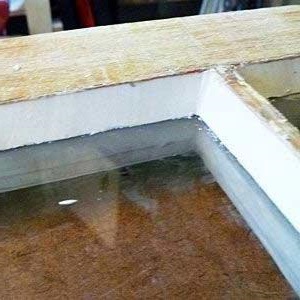
This guide provides instructions for the removal and replacement of deteriorated glazing putty in a single or sash window. It outlines the steps to clean the window frame thoroughly, replace the glass, and apply fresh glazing putty to effectively seal the window.
Additionally, the guide explains how to easily remove and replace window pins and nails without causing any damage to the glass pane.
Contents
- The Purpose Behind the Use of Glazing Putty
- Important Considerations: Asbestos and Lead Paint Awareness
- Replacing Glazing Putty and Single Pane Glazing
- Step 1: Potential Removal of the Window
- Step 2: Chiseling Out the Old Putty
- Step 3: Thoroughly Cleaning the Frame of Any Residual Putty
- Step 4: Extracting Nails, Window Pins, and Glass
- Step 5: Applying Primer to the Window Frame
- Step 6: Glass Cleaning and Proper Refitting to the Window Frame
- Step 7: Application of Fresh Glazing Putty
- Step 8: Painting the New Glazing Putty
- Is It Possible to Apply New Putty Over Old Putty?
- Alternatives to Glazing Putty Usage
- Video
The Purpose Behind the Use of Glazing Putty
In the past, before the widespread use of UPVC and double glazing, windows were typically crafted using either galvanized steel or timber to construct the frame. A single sheet of glass was inserted into this frame, and small nails or spriggs, as they were colloquially known, were hammered into the frame to secure the glass in its place.
It’s worth noting that contrary to popular belief, it is these nails, not the glazing putty, that held the glass within the frame. The primary role of the glazing putty was to seal the glass to the frame, creating a barrier against drafts and preventing water from seeping into the frame.
This misconception has led some DIY enthusiasts to attempt replacing glass panes using only putty, resulting in frequent failures and broken glass panes on the floor.

Fortunately, when the window putty was initially applied correctly, it could endure for many years before requiring replacement. Consequently, this task did not need frequent attention, bringing relief to homeowners.
Important Considerations: Asbestos and Lead Paint Awareness
If your windows are exceptionally old and have not had the putty replaced, especially in the last three decades, there’s a possibility that the putty might contain asbestos. If there’s even a slight chance of this being true, it is crucial not to disturb or touch the putty in any manner. Removal should be carried out by specialists in a controlled environment.
It is essential to exercise caution regarding asbestos exposure. Additionally, you should be mindful of the potential risks associated with lead paint. If the windows in question haven’t been worked on or restored since the late 1980s or early 1990s, there’s a likelihood that the existing paint could contain lead.
Replacing Glazing Putty and Single Pane Glazing
Step 1: Potential Removal of the Window
To simplify the task, if possible, remove the entire window along with its frame so you can work on it on a flat, stable surface. This approach greatly facilitates the process.
If you’re dealing with a side or top opening section, it should be relatively easy to unbolt it from the carriers and detach it. Once the window is removed, find a sturdy, level bench to place it on. Ideally, a purpose-built workbench is best, but a Workmate or a similar portable workbench will suffice.
Ensure that no part of the glass is in direct contact with any surface. Even slight pressure on the glass can cause it to break. After placing it on the flat surface, securely clamp the window down to prevent any movement during your work. When clamping, focus on the center of the window frame, and ensure that no pressure is exerted on the glass.
Helpful tip: Before clamping the window, place a thick sheet or blanket between the window and the work surface. This additional layer will absorb vibrations generated during hammering, reducing the risk of potential glass cracking.
If removing the window is not an option, you’ll need to work on it in its current location. While this approach presents more challenges, it is certainly not impossible to accomplish.

Step 2: Chiseling Out the Old Putty
With the window securely clamped in place, it’s time to remove the old putty. If you’re replacing the glass due to damage or accidental breakage, there’s no need to preserve the old putty. In fact, you can save time by breaking the remaining putty now. However, before taking a hammer to it, make sure to wear proper eye protection and thick, cut-resistant gloves. Cover the glass completely with an old, thick sheet or towel, then gently tap it with a hammer to shatter it.
Once broken, carefully remove any remaining glass shards (while wearing gloves) and collect as much of the glass as possible for proper disposal.
If you intend to keep the pane of glass intact, start by using a razor blade or a sharp knife to cut around the edge of the putty where it meets the glass. This will break the seal and make it easier to remove the old putty without damaging the glass.

Continue making several passes with the razor blade or sharp knife, applying gradual pressure each time to penetrate further into the putty.
Once the seal is sufficiently broken, it’s time to begin removing the putty. The most effective tool for this task is a hacking knife, as shown in the image below. This specialized tool is designed specifically for chopping out putty, filler, old cement, and similar materials.


Commencing from the middle of one side of the window, take your hacking knife and position the blade at an angle of approximately 45° against the putty, ensuring it is centred on the putty surround, as depicted in the accompanying image.
With a hammer, gently tap the flat edge of the knife until it starts to cut into the putty. The hacking knife is intentionally not extremely sharp to prevent any harm to the frame, which is likely if a wood chisel is used.

Continue tapping the hacking knife downwards towards the frame, and the pieces of putty will detach with a ping. You’ll quickly learn the appropriate force to apply.
Regardless of the frame’s orientation, always direct your blows towards the frame, avoiding striking towards the glass to prevent breakage.
Once a piece of putty is removed, assess its depth and the frame’s position to determine how deeply you can cut without accidentally damaging the frame.
Continue removing the old putty around the frame, ensuring you reach into every corner.

Move around the window as you work, avoiding awkward positions that may lead to accidents or damage.
Carefully progress along the glass perimeter, eliminating all traces of putty with the hacking knife until none remains.
To soften hard putty, employ a heat gun. Applying heat will soften the putty, making removal easier.
Run the heat gun back and forth over the putty, avoiding prolonged concentrated heat in one area, as excessive heat can cause the glass to crack. Shield the glass from direct heat using thick pieces of timber cut to size.
Once the putty softens, you can then proceed to remove it with the hacking knife.
Step 3: Thoroughly Cleaning the Frame of Any Residual Putty
Once you’ve removed the major chunks of putty, the next task is to carefully inspect the frame and eliminate any remaining small irregularities.
This step is crucial if you intend to keep the glass intact, as even the tiniest bumps can hinder the glass from moving freely. If the glass is restricted in its movement, it’s highly likely to sustain damage.
Be particularly meticulous when examining the corners, as these areas are the most vulnerable parts of the glass.
While a hacking knife remains the primary tool for fine cleaning of residual putty from the window frame, to access the corners effectively, you might find a putty knife or a window scraper beneficial due to their sharper edges.


Step 4: Extracting Nails, Window Pins, and Glass
Now that all the putty has been removed, you should have a clear view of any nails (also known as spriggs) or window pins. These components pose the final challenge in your quest to extract the glass.
Nails or window pins can prove a bit challenging to dislodge due to their proximity to the glass. The optimal approach for removing them is either to gently lift them with a small screwdriver, provided you can secure a grip, or to utilize needle-nose pliers to grasp the head and extract them.
Since they haven’t been driven in too deeply, as they need to support the glass, once you secure a firm hold on them, they should come out relatively easily.
Systematically work your way around the window, eliminating all nails and pins as you proceed. Once you’ve removed them all, conduct a final inspection to ensure nothing impedes the glass’s release.
Then, exert gentle pressure on one of the edges of the glass with the palm of your hand. If it shifts without resistance, that’s excellent news! Continue by taking out the pane and setting it aside out of the way.

However, if the glass appears immovable, it might have been affixed using silicone or a similar sealant. In this scenario, employ a razor blade to run along the edges of the glass on both sides and then attempt to nudge it. If it remains unyielding, consider using a silicone sealant remover or dissolver to see if it can weaken the bond enough for you to push the glass out.
Should all these efforts prove ineffective, you may find that your sole recourse is to shatter the glass and extract it in that manner.
Step 5: Applying Primer to the Window Frame
After removing the glass, employ a window scraper and sandpaper to meticulously cleanse the interior of the window reveal, also referred to as the “rabbet groove.” Ensure it is completely devoid of any sealant, putty, or old paint residue.
Once the area is meticulously cleaned, apply a high-quality exterior wood primer or paint system like Dulux Weathershield or Sadolin. Opt for a microporous paint system, which permits the timber to breathe and enables the paint to accommodate expansion and contraction, preventing cracking.

Step 6: Glass Cleaning and Proper Refitting to the Window Frame
Now that the inside of your frame or rabbet groove has been properly primed and undercoated, it’s time to reinsert the glass.
Apply a very thin layer of silicone around the rabbet groove. This step is essential for sealing the glass, preventing draughts, and keeping water out. While the new putty you’ll be using can handle this task, adding silicone provides an extra layer of protection.
However, if you anticipate removing the glass again soon, you might consider skipping this step, as it could make it more challenging to take the glass out later.
Gently place the glass back into the recess or rabbet groove, ensuring an even gap all around the perimeter.

Once the glass is in position, you can secure it by using nails, panel pins, or window pins to hold it within the frame.
Working in such proximity to delicate glass requires caution. If you have a steady hand, you can use a small tacking hammer to gently tap in the nails or window pins.
However, if you lack confidence in this technique, you can employ a “brad pusher” or a panel pin setting tool to insert the nails or brads. Additionally, the edge of a putty knife or scraper can be used to carefully push in window pins.
Since window pins and the thin nails or brads used here are easily pushed into a timber window frame, exercise care to avoid applying pressure directly on the glass. Ensure that no pressure is exerted on the glass or in a manner that could cause your tool to slip, ensuring a safe and secure fit for the glass within the frame.

Step 7: Application of Fresh Glazing Putty
After securing nails or pins to affix the glass within the frame, the next step involves applying putty. Various types of putty are available, but linseed oil-based putty is generally recommended for glazing windows due to its ease of use and durability.
Sometimes, linseed-based putties need to be warmed to enhance workability. To achieve this, place the sealed container of putty in hot water, making it more pliable.

Once the putty is malleable, ensure thorough mixing to evenly distribute the oil throughout, as it may separate over time. To apply the putty, shape it into a 10-12mm diameter “sausage” or use a putty knife to scoop and fill the groove along the window frame’s edge. Smooth out the putty using a putty or filling knife lubricated with white spirit, holding it at a 45° angle to the glass.

Work around the window, gently forcing the putty into the joint, ensuring it fills without air gaps or dips. Regularly dip the putty knife in white spirit to maintain lubrication. After completing one pass, repeat the process, focusing on smoothing out any lines and rough patches until the putty is perfectly smooth.

Achieving crisp corners requires careful mitring at precise 45° angles. Use the putty knife to create each mitre and then smooth it. Additionally, tidy up the joint where the putty meets the glass, ensuring a straight line. To remove excess putty, pull it towards the centre of the glass using the putty knife and wipe it away.
Once the putty is smooth with well-formed corners, allow it to dry according to the manufacturer’s recommendations, typically ranging from a few hours to a few weeks. To check if the putty is dry enough for painting, gently touch it after a week; if it feels hard, it is ready.

Step 8: Painting the New Glazing Putty
After your putty has solidified and set, the next crucial step is to apply paint. Painting is vital as it significantly extends the lifespan of the putty, often up to 10 years. Unpainted putty, on the other hand, typically lasts only around 1 year.
When painting the putty, ensure that you cover the joint where the putty meets the glass thoroughly. This seals the joint and prevents water or moisture from seeping in. Extend the paint onto the glass by approximately 3-5mm to create a tight seal.
Although you might be tempted to skip this process to maintain a neat appearance, it’s essential not to overlook it. Maintaining a straight and sharp painted line is crucial. This step is necessary and ensures a professional-looking outcome.
Once the putty is painted and dried, your task is complete. Your single-pane glazed window should now remain in good condition for at least 8 years. Although removing old putty from a single-pane glazed window might not be the most pleasant task, taking your time and working meticulously can result in a neat and professional finish.
Is It Possible to Apply New Putty Over Old Putty?
Certainly, you can apply fresh putty over existing old putty, but it’s essential to ensure that any remaining old putty is in satisfactory condition.
If you have a window with cracked or deteriorating putty, you can remove the loose parts and replace them without replacing the entire layer of putty.
When we refer to “good condition,” we mean that the old putty should be free from splits or cracks and firmly adhered to both the rabbet groove and the glass.
Additionally, if you encounter cracked putty, you can repair it by creating a thin paste using boiled linseed oil and glazing putty. Apply this paste into the cracks using a small brush to effectively mend the damaged areas.

When it’s fully dried, this substance will fill in any cracks and openings. However, just like when you replace putty, painting is necessary to make sure it endures over time.
Moreover, for the most effective safeguard and a polished appearance, it’s essential to complete the task thoroughly. This means removing all the old putty and replacing it with new material.
Alternatives to Glazing Putty Usage
Certainly, there are alternatives available instead of using glazing putty. One straightforward option is to replace the window with a new double-glazed unit, eliminating the need for putty.
However, in certain situations and locations, this may not be a feasible choice. For instance, if you have single-pane sash windows and reside in a conservation area, local regulations might mandate the retention of such windows.
In cases where keeping the traditional single pane glazed window is necessary or desired, an alternative to glazing putty is to utilize timber beads, mouldings, or quadrants (various terms for the same item).
These timber components come in various shapes, styles, and designs, with the half-round profile being the most common (as depicted in the image below). The moulding closely resembles the appearance of putty when applied to the window, providing a similarly sharp and neat finish.

Similar to the putty application, all corners of the moulding are meticulously cut at a 45-degree angle, ensuring a tidy appearance and an effective seal.
Before affixing any mouldings onto a window, a slender line of silicone is applied along the rabbet groove to establish a seal. The moulding is then secured in place using tiny nails or brads.
Just like with the putty, for optimal and enduring results, it is essential to paint the moulding or quadrant.



